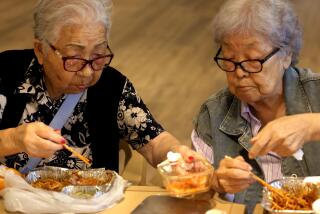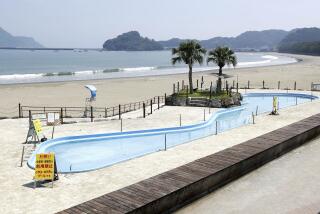DEVASTATING JOLT IN JAPAN : Family Survives, but Future Is Uncertain : Victims: The enormity of the disaster begins to sink in for the Kawasakis as they contemplate hardships ahead.
KOBE, Japan â Shimako Sumida, 74, her face blank with a shell-shocked look, sat Friday amid wall-to-wall blankets and people on the floor of the Nishinada Elementary School gymnasium, picking glumly at a cold breakfast of soggy rice and pickled plums.
âRelatives walked in yesterday to bring it,â said Sumidaâs 30-year-old great-nephew, Yasutaka Kawasaki. âHer teeth are bad, and she canât eat hard food.â
âUp until now itâs been just bread and water,â his mother, Setsuko Kawasaki, said as she ate a Japanese-style lunch box of rice, deep-fried breaded fish and pickles.
As the family ate, a voice came over the loudspeaker: âThe water truck has arrived. Those who need water, please come to get it.â
For tens of thousands living in Kobeâs disaster relief centers, the immediate survival crisis eased Friday as transportation arteries unclogged and deliveries of food, water and milk began arriving in sufficient quantities.
But as the immensity of their individual and collective disaster began to sink in, the Kawasakis realized that suffering from Tuesdayâs devastating earthquake, which killed more than 4,600 people, will afflict survivors for many years.
Ichi Matsu Ota, 82, a close friend of the Kawasakis and Sumida, was their most immediate concern. After the earthquake, Yoshideru Kawasaki, 58, Yasutakaâs father, had found Ota sitting at the top of the stairs of his ruined but still standing two-story home. Kawasaki, a steel worker, led Ota out to the safety of the nearby school.
But Ota suffered chest pains and breathing difficulty, and his friends managed to put out a call for an ambulance.
âIt did not come. Theyâd already had so many calls,â Yasutaka Kawasaki said. âAn ambulance finally came last night.â
*
Otaâs nephew dropped by the relief center Friday morning to inform the family that his condition was stable.
Sumidaâs sister, Sueko Kuwabara, suffered a back injury in the earthquake but had not even tried to see a doctor yet Friday.
âMy back hurts,â said Kuwabara, who was dressed in padded trousers and layers of sweaters. âBut so many people are dead. . . . Iâm happy to be alive.â
The Kawasakis live in an 11-story condominium building that suffered severe structural damage, including shattered concrete support columns exposing twisted steel. It may need to be torn down. There is no question that the wood-stucco-and-tile homes of Sumida and Kuwabara, who live together, and Ota will have to be demolished.
Yoshideru Kawasaki left the gymnasium midmorning Friday to attend a meeting of homeowners from his building. They met in a neighborhood park, near the tents and campfires of people who had chosen to stay there instead of on the crowded school grounds.
âWe need to have experts look at the building,â Kawasaki said after the meeting.
If repairs are expensive or the building must be rebuilt, it will be a financial disaster for the Kawasakis.
Only 3% of homeowners in Kobe have earthquake insurance, and the Kawasakis are not among them.
âItâs not just that we have little in savings,â Kawasaki said. âWe havenât paid off the mortgage yet. Weâve never had any extra money.â
He had not yet had time to ponder seriously how the financial loss will affect his retirement years.
âIf I think of it, I get really worried,â he said. âI donât know what weâll do.â
Kawasaki said no one knows whether the government will provide financial aid to repair or rebuild the structure. But he managed to keep his own loss in perspective.
âWhen you think of refugees in other parts of the world, this is nothing in comparison,â he said.
Twice Friday, the Kawasakis ventured back into their second-floor home in the badly damaged building, coming out with the rest of their food and some other necessities. Across the street, a concrete utility pole had tumbled over, largely crushing a wooden two-story home next to Kuwabara and Sumidaâs place. The two had no idea how long they would live in the high-ceilinged gymnasium, with its strong steel roof beams and no signs of quake damage.
âWe might be here a month,â said Yasutaka Kawasaki, an elementary school teacher. His mother predicted that authorities would move them elsewhere before then.
Kuwabara noted that people in Kobe had always believed that they were relatively safe from the threat of earthquakes.
âWith the mountain here, we thought there was a firm base,â she said. â(Now) itâs like after the bombing in World War II. I experienced that.â
Friday afternoon, as food and drink continued to pour into the center, a shipment of sushi arrived, a gift of the Okayama local government.
âThis is a famous product of Okayama,â Kuwabara said after the boxes of vinegary rice, shredded omelet, boiled shrimp, vinegary fish, mushrooms and lotus root were distributed.
Supply problems were solved, at least at this center.
Setsuko Kawasaki had gotten hold of a morning newspaper carrying a huge list of the dead, given by geographical area. She somberly searched for names she knew. She did not immediately find any, but that was little comfort; everyone believes that many bodies remain buried in the ruins.
âI never imagined thereâd be an earthquake and weâd become like this,â she said.
More to Read
Sign up for Essential California
The most important California stories and recommendations in your inbox every morning.
You may occasionally receive promotional content from the Los Angeles Times.










